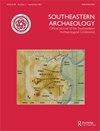Hickory nut storage and processing at the Victor Mills site (9CB138) and implications for Late Archaic land use in the middle Savannah River valley
Q1 Social Sciences
引用次数: 0
Abstract
ABSTRACT Despite the ubiquity of charred hickory nutshell in archaeological contexts throughout the Eastern Woodlands, evidence for nut processing and storage is elusive and ambiguous. To the extent that hickory nuts factored prominently in Indigenous foodways – particularly as a storable resource – mass processing was possibly specialized at times and sited in places for that express purpose. One such place was Victor Mills (9CB138) in Columbia County, Georgia. Excavations at this site of Early Stallings activity (ca. 4350–4050 cal BP) revealed an assemblage of pits, fire-cracked rock, anvils, hammerstones, fiber-tempered pottery, and soapstone slabs indicative of large-scale nut storage and processing. Given the seasonal ecology of hickory production, visits to Victor Mills for harvesting and storing nuts took place in the fall, but also at other times of the year, when stores were tapped and nuts processed for transport to sites of habitation. Put into larger context, nut storage at Victor Mills fits the conditions for concealment as outlined by DeBoer ([1988] Subterranean Storage and the Organization of Surplus: The View from Eastern North America. Southeastern Archaeology 7:1–20), that subterranean stores were established in places subject to raiding when left unattended. Implications follow for the land-use patterns of Early Stallings communities and their relationship to neighbors upriver.Victor Mills遗址(9CB138)山核桃仁的储存和加工及其对萨凡纳河谷中部晚古代土地利用的启示
尽管烧焦的山核桃果壳在整个东部林地的考古环境中无处不在,但坚果加工和储存的证据却难以捉摸和模糊。从某种程度上说,山核桃在土著食物方式中占有重要地位——尤其是作为一种可储存的资源——大规模加工可能是专门的,并且是为了这个明确的目的而选址的。佐治亚州哥伦比亚县的维克多·米尔斯(Victor Mills)就是这样一个地方。在这个石器时代早期(约4350-4050 cal BP)的发掘中,发现了一个由坑、火裂岩、铁砧、锤石、纤维回火陶器和肥皂石板组成的组合,表明了大规模的坚果储存和加工。考虑到山核桃树生产的季节性生态,人们会在秋天去Victor Mills收割和储存坚果,但也会在一年中的其他时候去,那时商店会被打开,坚果会被加工好运往居住地。在更大的背景下,Victor Mills的坚果储存符合DeBoer([1988]地下储存和盈余组织:来自北美东部的观点)所概述的隐藏条件。《东南考古学》(Southeastern Archaeology) 7:1-20)认为,地下仓库建在无人看管时容易遭到袭击的地方。对早期斯托林斯社区的土地利用模式及其与上游邻居的关系的启示。
本文章由计算机程序翻译,如有差异,请以英文原文为准。
求助全文
约1分钟内获得全文
求助全文
来源期刊

Southeastern Archaeology
Social Sciences-Archeology
CiteScore
1.40
自引率
0.00%
发文量
25
期刊介绍:
Southeastern Archaeology is a refereed journal that publishes works concerning the archaeology and history of southeastern North America and neighboring regions. It covers all time periods, from Paleoindian to recent history and defines the southeast broadly; this could be anything from Florida (south) to Wisconsin (North) and from Oklahoma (west) to Virginia (east). Reports or articles that cover neighboring regions such as the Northeast, Plains, or Caribbean would be considered if they had sufficient relevance.
 求助内容:
求助内容: 应助结果提醒方式:
应助结果提醒方式:


